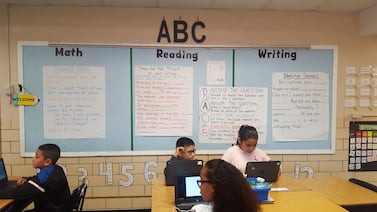The Illinois State Board of Education has released the first draft of a plan designed to help public school districts improve the way they teach reading — a goal that has taken on a new urgency since the coronavirus pandemic.
The 54-page document provides a roadmap emphasizing methods backed by research that educators can use to teach reading to students from birth to 12th grade, at a time when students across the state are not meeting national or state standards in reading.
“Equitable access to high-quality literacy instruction is not afforded to many of our students,” the state board said in the report. “A significant number of our students’ literacy needs are not being met, with some students disproportionately impacted.”
The state’s plan cites the 2022 results from the National Assessment of Educational Progress, a national exam that tests fourth, eighth, and 12th graders on subjects including reading, math, and science, which showed that about 40% of Illinois students lack “basic” reading skills. Children in third through eighth grade performed similarly on the state-mandated Illinois Assessment of Readiness exam in 2022.
For years, literacy advocates have been calling for the state board and lawmakers to encourage school districts to move away from “balanced literacy” — a now-debunked philosophy that says reading is a “natural process” — towards teaching phonics — an approach that teaches students the relationship between sounds and letters. Since 2019, states around the nation have been changing how schools teach reading to move away from balanced literacy.
This spring, the state’s general assembly passed a bill that requires the state board to create a literacy plan by Jan. 31, 2024 and to provide training opportunities to teachers that focus on teaching reading differently by 2025. This bill is currently waiting for Gov. J.B. Pritzker’s signature.
Starting next week, the Illinois State Board of Education will host listening sessions around the state to get feedback from educators, school officials, parents, and literacy advocates. It plans to release a revised draft in the fall.
Here are four highlights from the state’s draft literacy plan:
The Illinois literacy plan is a guide
The literacy plan provides schools with an evidence-based framework — called the Illinois Literacy Instructional Framework — to help educators teach students the relationship between sounds and words, expand their vocabulary, and master comprehension based on students’ age and grade level. The plan doesn’t give districts a curriculum to use in classrooms, but districts are encouraged to use the state’s curriculum evaluation tool, which will help them decide if the curriculum is high-quality and uses reading strategies backed by science.
The plan says “universal screening for literacy skills is essential” because it can help teachers figure out where gaps are in a student’s reading skills. However, universal screening is not currently required by the state. A bill in the spring that would have required screening to test for reading difficulties and disabilities such as dyslexia for children in kindergarten to second grade did not pass.
Reading is ‘not only an elementary school problem’
The state’s literacy plan emphasizes the importance of students learning how to read in elementary school, but it also notes that literacy development starts at birth.
The state board recommends parents, caregivers, and child care providers work with children from birth to three years of age on literacy to help them bond with caregivers and develop skills early. With young children, parents can use sounds like “ma” or “da,” pretend to have a conversation with infants when they make sounds, point out colors and shapes, and talk to babies during bath or feeding times, says the American Speech-Language-Hearing Association. The recommendation is backed by years of research showing that children exposed to a literacy-rich environment in their earliest years often perform better in school.
Once children are in preschool, they can begin to connect sounds to letters and words and begin to learn how to write.
As young children transition to elementary school, educators should focus on deepening students’ understanding of reading, writing, and words across subjects. Third grade is when Illinois students begin taking state-mandated tests, meaning that schools have to lay a strong reading foundation in kindergarten to second grade.
In middle schools, students should have a solid foundation for reading. The board recommends that if students struggle to recognize words, educators should intervene by assessing what skills they are missing and work with the students outside of class — although such assessments can be used any time in a student’s education.
Once students reach high school, the state plan says that students should be able to read and speak fluently, comprehend what they are reading, and be able to analyze what they are reading. While literacy skills are only explicitly taught in English language arts classes, the draft plan says reading should be incorporated into different subjects throughout the school day.
The state’s literacy draft says that high school teachers of all subjects play a role in developing students’ literacy skills.
Educators need training, support to teach literacy
Amanda Mullarky, a teacher and a parent of a student with dyslexia, told the State Board of Education at its monthly board meeting on Wednesday that in order for educators to support students in reading, teacher preparation programs need to adopt evidence-based practices.
Mullarky was a primary school teacher for eight years with a master’s degree in reading and is a certified reading specialist, but she struggled to help her son learn how to read.
“The balanced literacy methods I, along with his teachers, use aren’t effective for kids with dyslexia or in fact the majority of children,” Mullarky told the board. “Despite my reading specialist endorsement, I was left underprepared to help my own child.”
In a report released earlier this month from the National Center for Teacher Quality that examined how well teacher prep programs across the country are teaching reading instruction, most of the Illinois programs studied received failing grades. The report, which studied 700 programs around the country, looked at 15 programs in Illinois: Three received a D and nine programs were given an F for failing to teach the five core components of reading — phonemic awareness (learning sounds), phonics (the relationship between sounds and letters), fluency, vocabulary, and comprehension. Few programs focused on how to teach reading to students with disabilities or English language learners, the report found.
The draft literacy plan suggests that teacher preparation programs should help prospective teachers learn about the science behind reading, understand national and state standards for reading, find ways to help students learn how to read, and use assessments to find where students are struggling to read.
Although the goal of the literacy plan is to change how reading is taught for all grades, in a time of strained budgets and staffing shortages, districts should consider providing professional development to elementary school teachers, the state’s plan says.
English learners must learn literacy in two languages
The state’s literacy plan includes guidance for how teachers can support English learners in the classroom — which was a key concern for advocates who wanted to ensure that the needs of those students were included in any literacy plan developed by the state.
Since many English learners already know a language and its grammar rules, it’s important for teachers to provide instruction in both languages in preschool through fifth grade, according to the draft plan. Speaking, reading, writing, and listening should be taught in both languages with a larger amount of time spent in English, the plan recommends.
The State Board of Education provides other recommendations for English learners, such as making connections between languages by pointing out the differences and similarities between English and their native language and teaching students how to write in English. Teachers should use signs, charts, and books in the classroom to help students master vocabulary and grammar in English.







